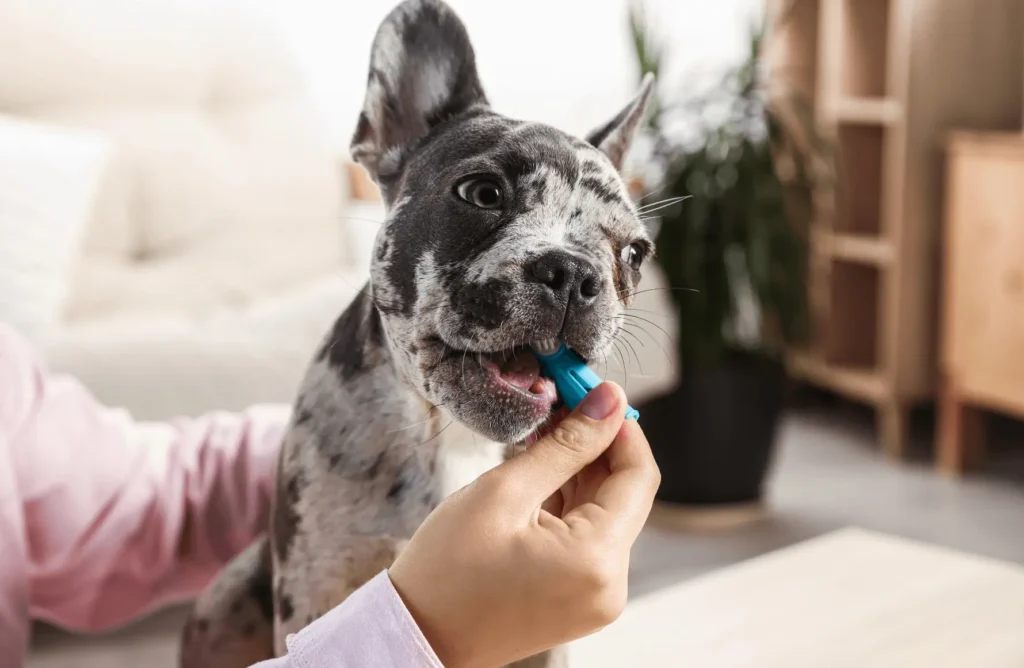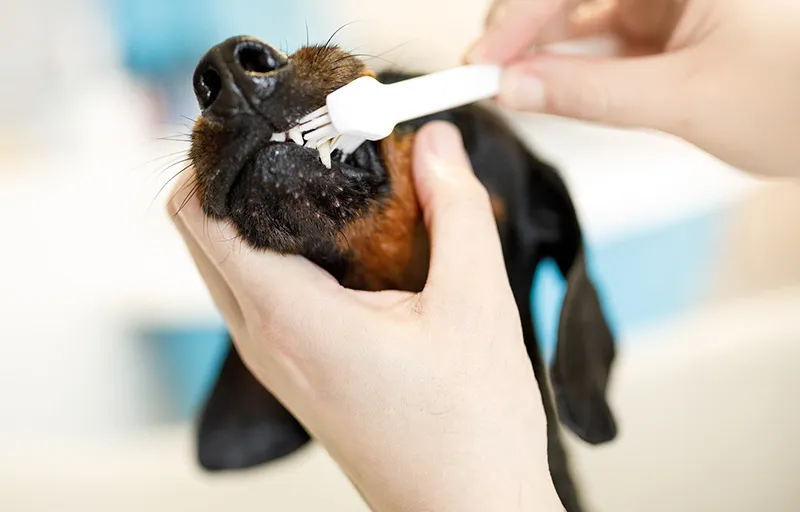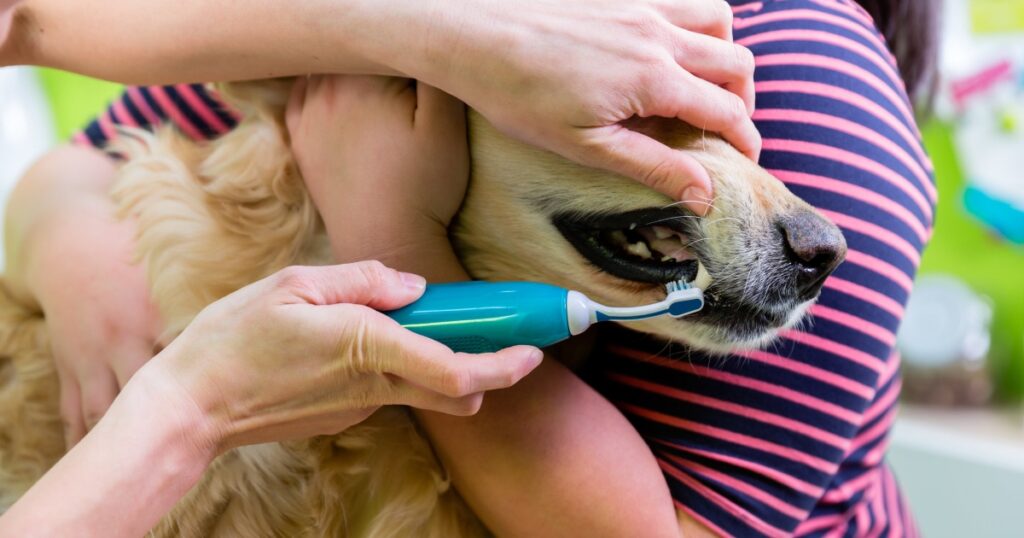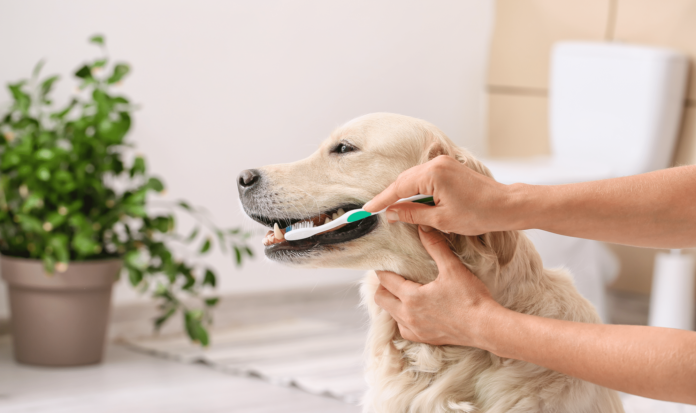The importance of dog dental hygiene
As responsible pet owners, we know that maintaining our furry friends’ dental health is just as crucial as our own. Dogs, like humans, can suffer from various dental problems if their oral hygiene is neglected. Plaque buildup, tartar formation, gum inflammation, and even tooth loss can occur if we don’t prioritize our pup’s dental care.
Regular professional cleanings and checkups are essential, but did you know that a simple DIY dental hygiene routine at home can go a long way in keeping your dog’s teeth and gums healthy? By taking a proactive approach to your dog’s dental care, you can prevent costly veterinary bills, alleviate discomfort, and ensure your canine companion enjoys a lifetime of good oral health.
READ ALSO : Unleash the Fun: Creative Ways to Keep Your Dog Entertained Indoors
Understanding common dental problems in dogs
Dogs are susceptible to a range of dental issues, including:
- Plaque and tartar buildup: If not removed regularly, plaque can harden into tartar, leading to gum inflammation and infection.
- Gingivitis: Inflammation of the gums, often caused by poor dental hygiene and plaque buildup.
- Periodontal disease: A severe form of gum disease that can damage the tissues and bones supporting the teeth.
- Tooth decay and cavities: While less common in dogs than in humans, poor dental care can still lead to tooth decay and cavities.
- Tooth loss: Untreated dental problems can ultimately result in the loss of teeth.
Recognizing these common issues and taking proactive steps to prevent them can significantly improve your dog’s overall health and quality of life.
Benefits of a DIY dental hygiene routine at home
Implementing a DIY dental hygiene routine at home offers numerous benefits for your canine companion:
- Cost savings: Regular professional dental cleanings can be expensive, but a simple home routine can help you avoid these costly vet visits.
- Improved oral health: Consistent home care can reduce the buildup of plaque and tartar, preventing the development of more severe dental problems.
- Reduced risk of health issues: Poor dental health has been linked to various health problems, such as heart and kidney disease. By maintaining your dog’s oral hygiene, you can help prevent these secondary conditions.
- Fresher breath: A clean, healthy mouth means fewer odor-causing bacteria, resulting in fresher-smelling doggy kisses.
- Increased comfort: Addressing dental problems early can alleviate any discomfort or pain your dog may be experiencing.
Essential tools and products for a DIY dog dental hygiene routine
To establish an effective DIY dental hygiene routine for your dog, you’ll need the following essential tools and products:
- Dog toothbrush: Soft-bristled toothbrushes designed specifically for canines are available in various sizes to accommodate different breed sizes.
- Dog toothpaste: Regular human toothpaste can be harmful if swallowed by your dog. Opt for pet-safe, enzymatic toothpastes in flavors your dog will enjoy, such as poultry or beef.
- Dental wipes or pads: These convenient products can be used to gently wipe away plaque and freshen your dog’s breath.
- Dental chews or treats: Look for products with the VOHC (Veterinary Oral Health Council) seal of approval, as they are designed to help reduce plaque and tartar buildup.
- Water additives: These supplements can be added to your dog’s drinking water to help promote oral health.
- Dental sprays or gels: These products can be applied directly to your dog’s teeth and gums to help combat plaque and freshening breath.
Having these essential tools on hand will set you up for success in maintaining your dog’s dental hygiene at home.
Step-by-step guide to brushing your dog’s teeth

Brushing your dog’s teeth may seem daunting at first, but with patience and positive reinforcement, it can become a stress-free routine for both of you. Follow these steps to get started:
- Introduce the toothbrush gradually: Allow your dog to sniff and become comfortable with the toothbrush before attempting to brush. Offer treats and praise to create a positive association.
- Start with the front teeth: Gently lift your dog’s lip and brush the outer surfaces of the front teeth, using small, circular motions.
- Work your way back: Gradually move to the back teeth, taking care to reach the hard-to-access areas.
- Be gentle and patient: Avoid scrubbing too hard, as this can cause discomfort. If your dog becomes agitated, stop and try again another day.
- Offer rewards: Praise and treat your dog throughout the process to reinforce the positive experience.
- Gradually increase duration: Start with short brushing sessions of 30 seconds to a minute, and gradually work up to longer durations as your dog becomes more comfortable.
Remember, consistency is key. Aim to brush your dog’s teeth at least a few times per week for optimal results.
Alternatives to brushing for dog dental care
If brushing your dog’s teeth is not an option, there are several alternative methods you can incorporate into your pet’s dental hygiene routine:
- Dental wipes or pads: These convenient products can be used to gently wipe away plaque and freshen your dog’s breath.
- Dental chews and treats: Look for VOHC-approved products that help reduce plaque and tartar buildup.
- Water additives: Adding dental supplements to your dog’s drinking water can help promote oral health.
- Dental sprays or gels: These products can be applied directly to your dog’s teeth and gums to help combat plaque and freshen breath.
- Professional cleanings: Regular professional cleanings by your veterinarian can help maintain your dog’s oral health, even if you don’t brush at home.
By incorporating a combination of these alternative methods, you can still effectively maintain your dog’s dental hygiene without the need for regular brushing.
Natural remedies for maintaining your dog’s dental health

In addition to the essential tools and products, you can also explore natural remedies to support your dog’s dental health:
- Coconut oil: Coconut oil has antimicrobial properties that can help reduce plaque and bacteria in your dog’s mouth.
- Mint or parsley: Adding a small amount of fresh mint or parsley to your dog’s food can help freshen their breath.
- Cranberries: The compounds in cranberries can help inhibit the growth of bacteria that cause plaque and tartar buildup.
- Turmeric: This anti-inflammatory spice can help reduce gum inflammation and promote healing.
- Green tea: The antioxidants in green tea may help protect against gum disease and tooth decay.
Incorporating these natural remedies into your dog’s diet or dental routine can provide an additional layer of protection for their oral health.
Tips for making the dental hygiene routine enjoyable for your dog
Establishing a positive and enjoyable dental hygiene routine is crucial for the long-term success of your DIY efforts. Here are some tips to make the process more pleasant for your canine companion:
- Start early: Introduce dental care at a young age to help your dog become accustomed to the routine.
- Use positive reinforcement: Offer plenty of praise, treats, and playtime as rewards during and after the dental care session.
- Make it a bonding experience: Turn the routine into a special one-on-one time with your dog, using a calm and soothing voice.
- Incorporate distractions: Try providing chew toys or engaging your dog in play before or after the dental care to make the experience more enjoyable.
- Tailor the routine: Adjust the duration, frequency, and approach based on your dog’s individual needs and preferences.
By making the dental hygiene routine a positive and rewarding experience for your dog, you’ll be more likely to maintain consistent care and prevent future dental problems.
How often should you perform a DIY dog dental hygiene routine?
The frequency of your DIY dog dental hygiene routine will depend on several factors, including your dog’s age, breed, and overall oral health. As a general guideline, consider the following:
- Puppies and young dogs: Aim to brush their teeth at least a few times per week to establish good habits early on.
- Adult dogs: Brush their teeth 2-3 times per week, or use alternative methods like dental chews and water additives daily.
- Senior dogs: Increase the frequency of brushing or alternative methods to 3-4 times per week, as older dogs are more susceptible to dental issues.
Regardless of your dog’s age, it’s essential to monitor their oral health and adjust the routine as needed. If you notice any signs of dental problems, such as red gums, bad breath, or difficulty eating, schedule a vet appointment immediately.
Signs that your dog may need professional dental care

While a consistent DIY dental hygiene routine can go a long way in maintaining your dog’s oral health, there may be times when professional veterinary intervention is necessary. Keep an eye out for the following signs that your dog may need to see a vet:
- Persistent bad breath: Foul-smelling breath that doesn’t improve with brushing or alternative methods may indicate a more serious dental problem.
- Difficulty eating: If your dog is reluctant to eat or seems to be in pain while chewing, it could be a sign of dental discomfort.
- Excessive drooling: Excessive saliva production can be a symptom of dental inflammation or infection.
- Visible tartar buildup: If you notice a significant amount of hardened tartar on your dog’s teeth, it’s time for a professional cleaning.
- Swollen or bleeding gums: Inflamed, red, or bleeding gums are a clear sign of gum disease that requires veterinary attention.
If you notice any of these concerning signs, schedule an appointment with your veterinarian to have your dog’s teeth and gums thoroughly examined and treated as needed.
Conclusion
Maintaining your dog’s dental hygiene at home is a simple yet essential aspect of their overall health and well-being. By implementing a consistent DIY dental routine, you can help prevent costly veterinary bills, alleviate discomfort, and ensure your furry friend enjoys a lifetime of good oral health.
Remember to start early, use positive reinforcement, and explore a variety of tools and methods to find what works best for your dog. With a little time and dedication, you can establish a dental hygiene routine that keeps your pup’s smile bright and their breath fresh.Ready to take charge of your dog’s dental health? Download our free guide to DIY dog dental hygiene routines and start providing your furry friend with the care they deserve. Click here to get your copy today!


